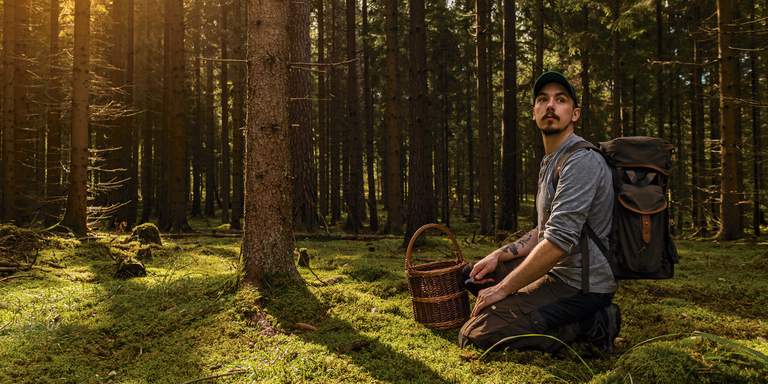Treasures in the underbrush - foraging with Niki Sjölund
Publish date: 22 February 2022
Nothing says fall in Sweden like a basket full of freshly picked mushrooms. What many don’t know is that there are mushrooms to be found all-year-round. "There even are edible species to be found in winter", explains professional forager Niki Sjölund.
There are few things that give the nature-loving Swedes as much pleasure as stumbling upon an undiscovered patch of chanterelles. As late summer rolls into early fall, you’ll see the golden-colored delicacy, along with king bolete, birch bolete, and other tasty forest treats peek out through the moss and leaf-covered forests of Stockholm. And chances are big that not one but several of your friends will humble-brag about their finds on social media.
Swedes have loved the mindfulness of forest rummaging and mushroom picking long before food trends started to slant towards the sustainable and ecological. And given our right to public access to most parts of nature, we’ve always been spoiled for riches Want mushroom stew for dinner? Hey, knock yourself out!
IF you can find them, that is.
Because if there’s one secret that the typical Swede treasures above all else, a secret they won’t share even with their closest friends or family, it’s where they go looking for mushrooms. Should you meet a Swede that, suspiciously enough, has no qualms about disclosing their favorite spot, you can bet they’re leading you on a wild goose chase.
Former chef and professional forager Niki Sjölund doesn’t mind telling you about his best mushroom spots, tough. On the contrary, he regularly shares his finds through his Instagram and has written the book “Vildplockat” about the edible treasures of the wild. Hailing from the far north of Sweden, Niki spent much of his childhood collecting berries and mushrooms with his family in the forests of southern Lappland.
"But not the fancy stuff", explains Niki. "Common mushrooms and berries, like chanterelle, raspberries, blueberries, and cloudberries".
Niki moved to Stockholm at the age of 18. After working in restaurants for many years, he started to notice the growing trend of locally cultivated and wild mushrooms and plants being introduced on the menus. His childhood hobby, lying dormant, suddenly awoke again and since 2015 he's supplied restaurants in Stockholm and Sweden with wild herbs, roots, berries, and mushrooms. We took the opportunity to pick his brain on the best-tasting forest-finds in Stockholm and where to find them!
When’s the best season for finding mushrooms?
"You can actually pick mushrooms all-year-round. There even are edible species to be found during winter. The best season tough is late summer going into fall. When the temperature has dropped somewhat, but before there’s frost on the ground".
What kind of terrain is best for finding mushrooms?
"Most edible mushrooms are symbiotic and grow close to certain plants and trees. Mixed forests with both leaf and pine trees are ideal. The more kinds of trees there are, the more kinds of mushrooms you’ll find".
You can actually pick mushrooms all-year-round. There even are edible species to be found during winter.
Swedes are usually very secretive about their best mushroom-spots. But could you at least give us some hints about general areas in Stockholm that are good for foraging?
"Oh, I have no problem with sharing good mushroom-spots. After all, there is a great abundance of them. Enough for everyone to get their fill, and then some. I myself live south of Stockholm, in Tullinge. So I usually go out foraging in the forests between Fruängen and Tullinge. Many nature reserves are also good mushroom spots. I like Gömmarens nature reserve. But Djurgården is pretty good as well if you’re looking for a place closer to the city. Just be sure to check what rules apply to the nature reserve you’re visiting if you’re even allowed to pick mushrooms. Normally you’ll find them at a notice board by the entrance".
Are there any tips or good accessories a beginner can use to determine if a mushroom is edible?
"Mushrooms are tricky. Under no circumstances should you take any chances when determining if something you found is safe to eat or not. There are about 10 000 species of mushroom in Sweden, of which about 100 are considered edible. In other words, there are lots of inedible ones and some, even in the relatively harmless Swedish nature, that are poisonous and deadly. Always bring an up-to-date mushroom guide or book".
Any personal favorite to eat?
"I love cooking with the mushrooms that the average picker barely acknowledges and just steps over. More for me, you know. To try and bring out the best possible flavors in underappreciated species and make them taste wonderful. But I can’t deny that a nice, chubby-looking, king bolete makes me giddy with excitement. Anything else would be telling a lie. My personal favorite flavor-wise though is the saffron milk cap".
Let’s assume you’re out of luck with mushrooms then, and already have a freezer full of blueberries and lingonberries. What other tasty treasures can you find in Stockholm’s forests?
"Oh, lots of great things. A little-known fact is that you can actually find both cloudberry and cranberry in marshlands on the outskirts of Stockholm. And there’s much to be found in any common garden as well; goutweed, chickweed, nettle, and garlic mustard for example. Basically plants that many consider as weeds, but actually taste great".
Rummager beware
Edible mushrooms in Sweden are plentiful and delicious. But of the 10 000 wild mushroom species, only 100 are safe to eat. Many are inedible and taste terrible, and some are downright poisonous and deadly.
A smartphone might come in handy to identify the mushrooms of course. But considering that your network connection might be unreliable out in the woods, a good book might be preferable.
Still unsure about a mushroom? Leave it alone!
